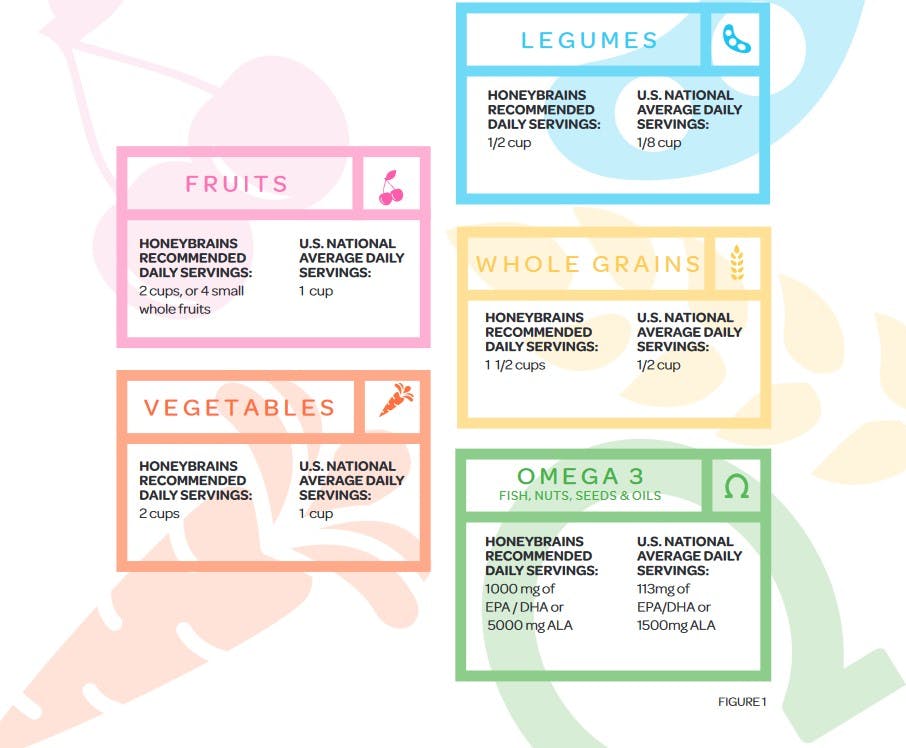THE HB FIVE FOOD GROUPS & THE SCIENCE BEHIND THEM

The HB Five Food
Groups & The Science
Behind Them
The HB Five Food
Groups & The Science
Behind Them

The Honeybrains menu was created after reviewing the science related to food and the human brain. As far back as the time of Hippocrates (400 BC), we have known that food is an essential health factor [1]. Over centuries, we have accumulated a massive amount of scientific information about food and health. Observational studies, randomized trials and meta-analyses are examples of studies available to health researchers to answer different health questions about food. Observational studies can help to identify a relationship between two health factors. Randomized trials can prove that one health factor is not only related to, but also causative of, the other. Meta-Analyses, also known as systematic reviews, can ensure that findings, either from observational studies or randomized trials, reflect the underlying truth of the matter by grouping all studies to date on a specific topic and considering the evidence as a whole. To create the Honeybrains menu, we analyzed all these types of studies and reviewed the strength of the evidence based on the study design. In creating the menu, we also considered ancient dietary cultural wisdom, such as the ingredient combinations found in traditional foods. In some regions of the world, known as “Blue Zones,” people who eat certain ethnic foods live much longer than average. It turns out that modern scientific research is consistent with what people in living in Blue Zones already know about how to eat for health.
We found that the science supporting nutrition and its association with brain health and longevity can be simplified into five food groups (legumes, whole grains, fruits, vegetables, and foods high in Omega fats) (collectively the “HB Five Food Groups”), plus healthful garnishings (herbs, spices, fermented foods and raw sweeteners from nature)(collectively “Good Garnishings”) [2-6]. These foods are good for us because they provide all the body and brain nutrients we require each day [7-11]. They can also be combined through culinary art to create delicious and enjoyable experiences. That’s why they form the foundation of the Honeybrains menu. We believe that everyone should have the opportunity to live a brain healthy lifestyle, and that it should be incredibly fun.
We also know that most of us aren’t getting enough essential brain nutrients because we aren’t consuming enough of the HB Five Food Groups each day [see Figure 1]. Essential brain nutrients cannot be produced by the body, so they must be obtained through food. Essential brain nutrients include color pigments (i.e., Lutein, Carotene and Lycopene), Omega fats (i.e., 3, 6 and 9), fiber (i.e., soluble and insoluble), vitamins (i.e., B and D), and minerals (i.e., Iron, Magnesium, Potassium). Essential brain nutrients improve the function of the body systems that nourish and protect the brain (i.e., the Digestive, Circulatory and Metabolic Systems). Currently, on average, we are getting about half of the essential nutrients our bodies and brains crave [12-15]. These essential brain nutrients can be obtained through eating the HB Five Good Groups and Good Garnishings.
The HB Five Food Groups and Good Garnishings are proven by science. The more fruits and vegetables we eat, the better the health effect, especially if we aren’t eating enough [16]. People who eat more fruits and whole grains have better metabolisms [17]. People who eat whole grains also seem to live longer [18]. Legumes, such as beans, peas, lentils, which are often eaten with whole grains, are particularly good for the heart and brain because they are high in B vitamins and fiber [19]. Nuts, seeds and fish are good for us largely due to their high content of Omega fats. Omega fats are beneficial for the brain because the brain is made of fat. People with more Omega fats in their blood have bigger brains [20]. A good diet can even lower inflammation in the blood, which can impact our circulatory health [21]. Like the HB Five Food Groups, Good Garnishings (herbs, spices, fermented foods and raw sweeteners from nature) are good for the brain because they have essential nutrients that support digestive, circulatory and metabolic health [22-23]. Fermented foods include aged foods, such as kefir, blue cheese, tofu, tempeh, vinegar and soy sauce, and anything pickled, such as pickles, kimchi or sauerkraut.
In summary, according to the current science of food and the brain, if we eat from the HB Five Food Groups (legumes, whole grains, fruits, vegetables, and foods high in Omega fats), and use Good Garnishings (herbs, spices, fermented foods and raw sweeteners from nature), we can get all of our essential brain nutrients to live a long and happy life. This view is consistent with current dietary guidelines of the National Institute on Aging and numerous scientific studies [24]. Of course, every person is different, so personalized approaches to diet and health are necessary [25].
At Honeybrains, we kept it simple and created a delicious menu that celebrates the facts. Future research will inform our menu updates. We hope you love them!
Figure 1: Honeybrains Food Groups Daily Target Table

Download this blog Here.

